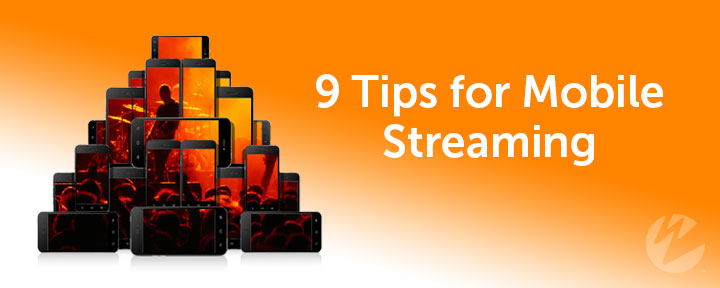Live Mobile Streaming: Nine Tips for Success

Thanks to apps like Periscope, Facebook Live, and YouNow, streaming video from mobile devices is fun, easy, and gaining popularity. But ensuring your live-streaming content is engaging requires some thought. Let’s look at a few ways to make your live mobile streams look and sound great, and then dig a bit deeper to discuss firewalls, privacy, and copyright. With nine key considerations in mind, you’ll have a solid foundation for your mobile streaming projects.
1. Bandwidth
Wi-Fi is usually preferred over 4G, 3G, and other mobile data connections. It often provides greater throughput, and the cost of streaming crisp video over a mobile data connection can be surprisingly high. Whether using Wi-Fi or cellular data, you’ll want to send a high-quality stream from your mobile device to your streaming service or server (such as Wowza Streaming Cloud or Wowza Streaming Engine), which will then convert your content into multiple lower quality levels and various formats to ensure every viewer can get the best stream his or her network conditions and viewing device allow at any given moment. If you’re broadcasting a planned event, try testing your bandwidth speed (typically using a free app, such as Speedtest) and streaming in advance, ensuring the outbound stream from your mobile device is using 80% or less of the available bandwidth.
2. Lighting
Capturing video of a live event won’t have much value if your viewers can’t see the subject(s) well. Some events are already well-lit, but others (such as live interviews indoors or at night) need a bit of help. Fortunately, a growing selection of inexpensive, bright, lightweight, and portable LED lighting options are available from online retailers.
3. Steadiness
Unless you’re going for the shaky handheld look of The Blair Witch Project, you’ll want steady video capture so your audience doesn’t feel seasick. Inexpensive accessories allow you to put your mobile device on a tripod for shooting stationary video. Using the same kind of clip with a monopod may be a good option if you’re shooting occasional movement. For full-motion shots, your best bet is to buy a device such as the Steadicam Smoothee to keep the camera stable as you move, but options range from high-end electric gimbals to low-budget stabilizers you build yourself using online plans and common plumbing supplies.
4. Audio
High-quality audio is vital for retaining an audience—hard-to-hear or crackly audio turns people off more quickly than bumpy or dark video. Good external microphones are numerous, including reasonably priced analog shotgun and wired lavalier mics, as well as sophisticated digital microphones that plug into your data ports.
5. Power
Compressing raw video from your mobile device’s camera into something that can be streamed usually takes a lot of processing power, which can quickly run down a phone or tablet battery. If you’re broadcasting an event that will last more than a few minutes, it’s best to connect to an external power supply, such as a plug-in charger or a portable battery.
6. Interruptions
Nothing puts the brakes on a broadcast faster than an incoming phone call or pop-up notification that causes your streaming app to stop. To ensure you don’t get interrupted, put your mobile device in Do Not Disturb mode before you start.
7. Firewalls
If you’re planning to broadcast video from your mobile device over Wi-Fi, you may need to get an outbound port opened in the network firewall so your video stream can reach your external streaming server or service. Broadcasting apps often use the RTMP, RTSP, or (in the case of Wowza GoCoder) WOWZ protocol to push their streams. (Check with your live-streaming app provider to learn the recommended protocol and port to use.) If the firewall and network are appropriately configured, the security risk of opening up this outbound port will be very low. As appropriate, engage early with your network administrators to ensure they’re on board with your plans so they can open any ports needed, and so they don’t misinterpret an outbound data spike as a data breach and shut down your stream midbroadcast.
8. Privacy
Regardless of the location from which you plan to broadcast, ensure there are no privacy policies that might block your plans. For example, many schools and houses of worship are understandably concerned about sharing live broadcasts that could reveal children’s identity or personal details outside of their internal community.
9. Copyright
If your live broadcast will include purchased or performed content such as music, plays, videos, or readings of written works, you probably need to obtain permission to use each of these. Simply owning purchased sheet music, a CD, a DVD, or a book that contains the content does not mean you have the rights to digitally transmit it. As a starting point, this Copyright Compliance document from Amazon Web Services might be useful. (Although it’s geared toward churches, it can be applied to a wide array of contexts.)
Want to learn more about live mobile streaming and how to integrate streaming into your own mobile app? Check out these related posts:
Live Mobile Broadcasting: What Are You Waiting For?
Democratization of Streaming, Mobile Streaming Apps & More—An Interview




